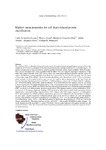Mostrar o rexistro simple do ítem
Markov Mean Properties for Cell Death-Related Protein Classification
| dc.contributor.author | Fernández-Lozano, Carlos | |
| dc.contributor.author | Gestal, M. | |
| dc.contributor.author | González-Díaz, Humberto | |
| dc.contributor.author | Dorado, Julián | |
| dc.contributor.author | Pazos, A. | |
| dc.contributor.author | Munteanu, Cristian-Robert | |
| dc.date.accessioned | 2017-01-20T11:01:36Z | |
| dc.date.available | 2017-01-20T11:01:36Z | |
| dc.date.issued | 2014-01-31 | |
| dc.identifier.citation | Fernández-Lozano C, Gestal M, González-Díaz H, Dorado J, Pazos A, Munteanu CR. Markov mean properties for cell death-related protein classification. J Theor Biol. 2014;349:12-21 | es_ES |
| dc.identifier.issn | 0022-5193 | |
| dc.identifier.issn | 1095-8541 | |
| dc.identifier.uri | http://hdl.handle.net/2183/17985 | |
| dc.description.abstract | [Abstract] The cell death (CD) is a dynamic biological function involved in physiological and pathological processes. Due to the complexity of CD, there is a demand for fast theoretical methods that can help to find new CD molecular targets. The current work presents the first classification model to predict CD-related proteins based on Markov Mean Properties. These protein descriptors have been calculated with the MInD-Prot tool using the topological information of the amino acid contact networks of the 2423 protein chains, five atom physicochemical properties and the protein 3D regions. The Machine Learning algorithms from Weka were used to find the best classification model for CD-related protein chains using all 20 attributes. The most accurate algorithm to solve this problem was K*. After several feature subset methods, the best model found is based on only 11 variables and is characterized by the Area Under the Receiver Operating Characteristic Curve (AUROC) of 0.992 and the true positive rate (TP Rate) of 88.2% (validation set). 7409 protein chains labeled with “unknown function” in the PDB Databank were analyzed with the best model in order to predict the CD-related biological activity. Thus, several proteins have been predicted to have CD-related function in Homo sapiens: 3DRX–involved in virus-host interaction biological process, protein homooligomerization; 4DWF–involved in cell differentiation, chromatin modification, DNA damage response, protein stabilization; 1IUR–involved in ATP binding, chaperone binding; 1J7D–involved in DNA double-strand break processing, histone ubiquitination, nucleotide-binding oligomerization; 1UTU–linked with DNA repair, regulation of transcription; 3EEC–participating to the cellular membrane organization, egress of virus within host cell, class mediator resulting in cell cycle arrest, negative regulation of ubiquitin-protein ligase activity involved in mitotic cell cycle and apoptotic process. Other proteins from bacteria predicted as CD-related are 2G3V - a CAG pathogenicity island protein 13 from Helicobacter pylori, 4G5A - a hypothetical protein in Bacteroides thetaiotaomicron, 1YLK–involved in the nitrogen metabolism of Mycobacterium tuberculosis, and 1XSV - with possible DNA/RNA binding domains. The results demonstrated the possibility to predict CD-related proteins using molecular information encoded into the protein 3D structure. Thus, the current work demonstrated the possibility to predict new molecular targets involved in cell-death processes. | es_ES |
| dc.description.sponsorship | Xunta de Galicia; 10SIN105004PR | es_ES |
| dc.description.sponsorship | Instituto de Salud Carlos III; PI13/00280 | es_ES |
| dc.language.iso | eng | es_ES |
| dc.publisher | Elsevier | es_ES |
| dc.relation.uri | http://dx.doi.org/10.1016/j.jtbi.2014.01.033 | es_ES |
| dc.rights | Atribución-NoComercial-SinDerivadas 3.0 España | es_ES |
| dc.rights.uri | http://creativecommons.org/licenses/by-nc-nd/3.0/es/ | * |
| dc.subject | Markov chains | es_ES |
| dc.subject | Cell death | es_ES |
| dc.subject | Protein classification | es_ES |
| dc.subject | QSAR | es_ES |
| dc.subject | Machine learning | es_ES |
| dc.title | Markov Mean Properties for Cell Death-Related Protein Classification | es_ES |
| dc.type | info:eu-repo/semantics/article | es_ES |
| dc.rights.access | info:eu-repo/semantics/openAccess | es_ES |
| UDC.journalTitle | Journal of Theoretical Biology | es_ES |
| UDC.volume | 349 | es_ES |
| UDC.startPage | 12 | es_ES |
| UDC.endPage | 21 | es_ES |
Ficheiros no ítem
Este ítem aparece na(s) seguinte(s) colección(s)
-
GI-RNASA - Artigos [195]






